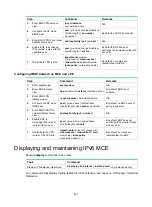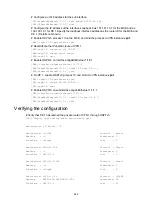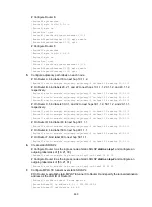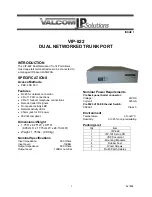
544
Configuring static SR over MPLS
Overview
About SR and SRLSP
Segment Routing (SR) is a source routing technology. The source node selects a path for the
packets, and then encodes the path as a list of segments in the packets. Each segment is identified
by the segment identifier (SID). The SR nodes forward the arriving packets based on the SIDs in the
packets. Only the source node needs to maintain the path status.
There are the following types of segments:
•
Prefix
segment
—SIDs are assigned to nodes based on destination address prefix. The nodes
create prefix-specific forwarding entries.
•
Adjacency
segment
—SIDs are assigned to nodes based on adjacency.
SR can operate with MPLS. In an MPLS network, SR uses MPLS labels as SIDs to forward packets
on an LSP. Such an LSP is referred to as a segment routing label switched path (SRLSP).
SRLSPs are special CRLSPs established based on SR. An MPLS TE tunnel can contain one or
multiple SRLSPs. The source node (ingress node of an MPLS TE tunnel) forwards packets that are
routed to the MPLS TE tunnel interface through the SRLSPs.
How static SR over MPLS works
Static SR over MPLS provides the following methods for establishing static SRLSPs:
•
Prefix
method
—Each node on the SRLSP has the label information for other nodes. The label
information is prefix-specific and manually configured. It includes the incoming label, outgoing
label, and next hop. The label stack on the ingress node specifies all the other nodes that the
forwarding path traverses.
•
Adjacency
method
—Each node on the SRLSP has the label information for its adjacencies.
The label information is manually configured and includes the incoming label and next hop. The
label stack on the ingress node specifies all the links that the forwarding path traverses.
NOTE:
The device supports only the adjacency method for static SRLSP establishment.
shows how a static SRLSP forwards a packet.
1.
Ingress node Device A adds a label stack to the packet and then forwards it to Device B.
The label stack is an ordered list of adjacency SIDs of the nodes that the SRLSP traverses: 201,
202, and 203.
2.
When Device B receives the packet, it removes the top label of the label stack (label 201) and
then forwards the packet to the next node Device C.
3.
When Device C receives the packet, it removes the top label of the label stack (label 202) and
then forwards the packet to the next node Device D.
4.
When Device D receives the packet, it removes the last label (label 203) of the packet and then
forwards the packet (an IP packet) to Device E (the egress node).
5.
When egress node Device E receives the packet, it forwards the packet to the destination IP
address.
















































